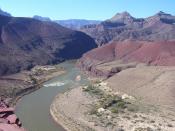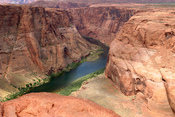Geographers can tell you that the one thing that most rivers and their
adjacent flood plains in the world have in common is that they have rich
histories associated with human settlement and development. This
especially true in arid regions which are very dependent upon water. Two
excellent examples are the Nile and the Tigris-Euphrates rivers which
show use the relationship between rivers and concentrations of people.
However, the Colorado River is not such a good example along most
segments of its course. There is no continuous transportation system
that parallels the rivers course, and settlements are clustered. The
rugged terrain and entrenched river channels are the major reasons for
sparse human settlement. We ask ourselves, did the Colorado River help
or hinder settlement in the Western United States?
As settlers began to move westward, the Southwest was considered
to be a place to avoid. Few considered it a place to traverse, to spread
Christianity, and a possible source of furs or mineral wealth.
Finding a
reliable or accessible water source, and timber for building was
difficult to find. There was a lack of land that could be irrigated
easily.
By the turn of the century, most present day cities and towns
were already established. Trails, roads, and railroads linked several
areas with neighboring regions. Although the Colorado River drainage
system was still not integrated. In the mid 1900's many dams had been
built to harness and use the water. A new phase of development occurred
at the end of the second World War. There was a large emphasis on
recreation, tourism, and environmental preservation.
The terrain of the Colorado River is very unique. It consists of
Wet Upper Slopes, Irregular Transition Plains and Hills, Deep
Canyonlands, and the Dry Lower Plains.
Wet Upper Slopes: Consist of numerous streams that...



Awesome
thank you so much for posting this, it really helped me a lot when i was studying for my test, great paper, explained it well and it really helped a lot thanks so much
0 out of 0 people found this comment useful.